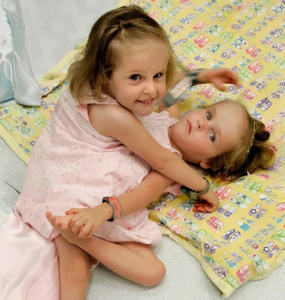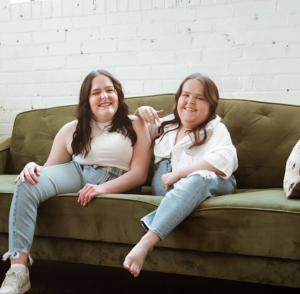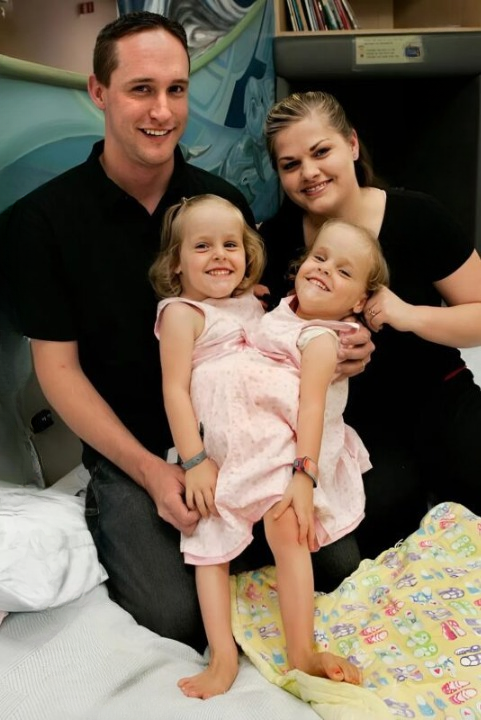Childbirth is one of the most profound experiences in human life, often filled with hope, anticipation, and dreams for the future. But occasionally, medical conditions present challenges so rare and complex that they push the boundaries of medicine, patience, and human resilience.
One such case is the story of Kendra and Maliah, conjoined twins born sharing a portion of their bodies and some vital organs. Their journey — from birth, through a pioneering separation surgery, to the lives they lead today at 19 years old — demonstrates the incredible advancements of modern medicine, the strength of family bonds, and the resilience of the human spirit.
This article explores their story in depth, examining the medical, emotional, and social aspects of their journey. It also provides insight into how families navigate extraordinary medical challenges and how children adapt, grow, and thrive after life-altering surgeries.
The Early Days: Conjoined at Birth
Kendra and Maliah were born with their bodies partially fused, sharing some organs, a condition that affects fewer than one in 200,000 live births worldwide. Conjoined twins present one of the most complex medical scenarios for neonatal care teams, requiring a multidisciplinary approach involving obstetricians, pediatric surgeons, cardiologists, and often, ethicists.
In the early months of life, the twins’ parents focused on providing a nurturing environment while closely monitoring their daughters’ health. Routine pediatric checkups were accompanied by frequent consultations with specialized surgeons to assess the feasibility of separation in the future.
Conjoined twins often face numerous challenges in infancy, including:
-
Difficulty in feeding and digestion due to shared organs or systems
-
Limited mobility and delayed motor development
-
Increased vulnerability to infections and complications
Despite these obstacles, Kendra and Maliah’s early life was marked by remarkable progress. Their parents provided unwavering support, ensuring that every developmental milestone was approached with patience and care.

The Decision for Separation Surgery
By the age of four, the twins’ parents faced one of the most difficult decisions of their lives: whether to proceed with a complex surgical separation. At that time, pediatric surgeons had limited experience separating twins who shared organs, and success could not be guaranteed. The potential risks were substantial, including life-threatening complications and permanent disability.
The decision involved:
-
Comprehensive medical evaluations, including CT scans, MRI imaging, and 3D modeling to assess organ sharing and vascular structures
-
Consultation with a multidisciplinary surgical team, including pediatric surgeons, anesthesiologists, and intensive care specialists
-
Ethical deliberation on quality of life, survival probability, and long-term outcomes
Ultimately, after careful deliberation and consultation, the parents gave their consent, understanding both the high-risk nature of the procedure and the potential for their daughters to lead independent lives.
The Groundbreaking Surgery
The surgery itself lasted approximately 26 hours, making it one of the most complex cases of its kind at the time. Such procedures require precise coordination among dozens of medical professionals, including surgeons, nurses, anesthesiologists, and support staff.
Key aspects of the surgery included:
-
Separation of shared organs: Surgeons carefully divided tissues, ensuring that both twins would retain functional organ systems.
-
Reconstruction and stabilization: Once separated, each twin’s body required significant reconstruction to maintain structural integrity and functionality.
-
Monitoring and adaptation: Vital signs, oxygenation, and blood flow were continuously monitored, and contingency plans were in place for potential emergencies.
The medical team accomplished something previously considered nearly impossible: they separated twins sharing organs successfully. The immediate post-operative period was critical, requiring close monitoring in a pediatric intensive care unit.

Recovery and Rehabilitation
The physical recovery was arduous. Both Kendra and Maliah were left with only one leg each, presenting new challenges in mobility, balance, and independence. The twins faced months of physical therapy, occupational therapy, and adaptive training to regain functionality.
Learning to Walk
For children who had previously relied on shared coordination, learning to walk independently involved:
-
Developing muscle strength in previously underutilized limbs
-
Training balance and coordination to compensate for missing limbs
-
Adjusting to prosthetics or mobility aids as necessary
With the support of therapists and their family, both girls made remarkable progress. Early steps were cautious and tentative, but consistent rehabilitation fostered increasing confidence and autonomy.
Psychological and Emotional Adaptation
Separation also required mental and emotional adaptation. Children who have lived as conjoined twins often develop:
-
Deep interpersonal awareness: Each child must learn boundaries and independence while maintaining a connection to their sibling
-
Coping mechanisms: Adjusting to bodily changes, medical interventions, and new social dynamics
-
Identity formation: Developing individual personalities while respecting the shared past
Kendra and Maliah’s parents played a critical role in providing emotional support, celebrating progress, and encouraging self-expression through play, creativity, and education.
Childhood and Adolescence: Exploring Independence
Over the following years, Kendra and Maliah adapted to living separate lives while maintaining a unique bond. Their story highlights not only medical triumph but also the psychosocial challenges that accompany major medical interventions.
Education and Social Integration
Starting school presented both opportunities and challenges:
-
Adjusting to environments not always accessible for children with limb differences
-
Navigating social interactions and addressing curiosity or stigma from peers
-
Developing resilience and communication skills to advocate for their needs
Teachers, classmates, and school communities played an important role in fostering inclusion and self-esteem. Both girls thrived academically and socially, embracing hobbies, friendships, and team activities.
Discovering a Passion for Creativity and Social Media
As the twins grew older, they discovered social media as a platform for expression and connection. They shared insights into daily life, adaptive strategies, and personal experiences in an honest, engaging manner.
Their content includes:
-
Fashion and styling tips adapted for mobility needs
-
Makeup tutorials and creative expression
-
Dance routines highlighting coordination, rhythm, and energy
By combining creativity with authenticity, Kendra and Maliah attracted hundreds of thousands of followers, inspiring viewers with their courage, resilience, and joyful approach to life.
The Impact of Social Media on Identity and Advocacy
Social media allowed the twins to:
-
Showcase independence: Demonstrating their abilities rather than limitations
-
Educate others: Raising awareness about limb differences, adaptive techniques, and inclusive design
-
Foster community: Connecting with children, families, and young adults facing similar challenges
Their growing influence extended beyond entertainment. Kendra and Maliah became advocates for children with medical needs, participating in campaigns, charity events, and public speaking engagements.
Medical and Scientific Significance
The twins’ case remains significant from a medical perspective for several reasons:
-
Pioneering separation surgery: Their operation contributed to the body of knowledge regarding organ-sharing twins, guiding future surgical protocols.
-
Post-operative rehabilitation research: Long-term tracking of mobility, muscle adaptation, and prosthetic integration informs pediatric physiotherapy practices.
-
Psychosocial development studies: Observing their social and emotional adaptation provides insights into childhood resilience and identity formation after significant medical intervention.
Medical journals have noted that such cases highlight the importance of multidisciplinary care, combining surgical expertise with rehabilitation, psychological support, and family engagement.
Philanthropy and Community Engagement
Beyond personal achievement, Kendra and Maliah have dedicated time and energy to giving back. They participate in charity projects supporting children with special medical needs, offering mentorship and hope.
Their contributions include:
-
Visiting hospitals to meet children facing surgeries or disabilities
-
Sharing motivational messages through online platforms
-
Collaborating with organizations to raise awareness and funds for pediatric care
Through these actions, they demonstrate that medical survival is only part of the journey; thriving and inspiring others is equally powerful.
Living Separate, Yet Connected Lives
Today, at 19 years old, Kendra and Maliah live independent lives while remaining deeply connected. Their story exemplifies:
-
Resilience: Overcoming significant medical challenges through courage and perseverance
-
Family strength: Parental support, guidance, and advocacy are central to their journey
-
Medical achievement: Highlighting the possibilities of modern surgical and rehabilitative medicine
Each day, they continue to show that even extreme life challenges can be met with determination, creativity, and mutual support.
The Transformation: From Fragile Infants to Confident Young Women
The most striking aspect of their story is the transformation over time:
-
From physically fragile conjoined twins, dependent on each other for mobility
-
To young adults with confidence, energy, and the ability to pursue personal goals
-
Maintaining a unique bond while developing individual identities, skills, and aspirations
Photographs and videos of Kendra and Maliah today reveal not just physical changes but emotional and psychological growth. They have evolved into role models, demonstrating that limitations do not define potential
